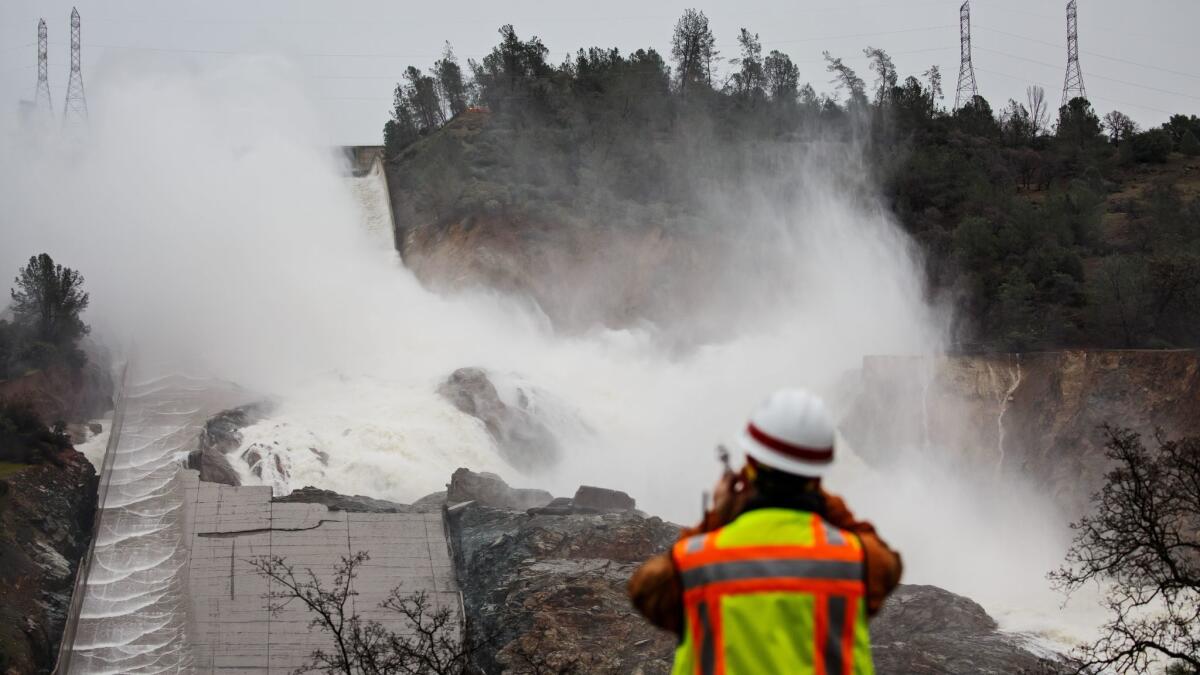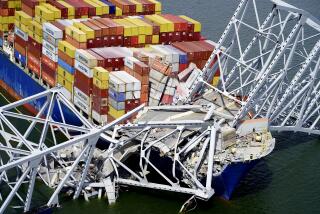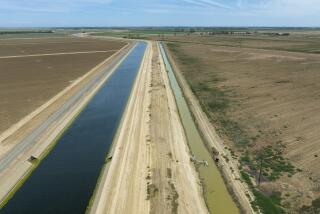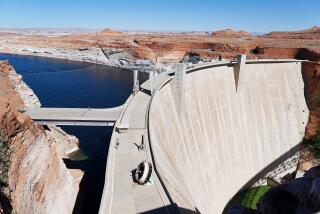Human error played a role in Oroville Dam spillway failure, report finds

Complacency, bureaucracy and an inadequate safety culture led to the failure last year of the Oroville Dam spillway, according to an independent investigation report released Friday.
The findings point to human error by a number of organizations but say that the dam’s owner, the California Department of Water Resources, was “significantly overconfident and complacent about the integrity of its State Water Project civil infrastructure, including dams.”
It describes the department as an “insular organization which inhibited accessing industry knowledge and developing needed technical expertise.” Within the department, the engineering division clashed with the operations and maintenance staff, resulting in a “lack of mutual respect,” it found.
There was a belief inside the department that became “mythologized” over the decades that it built the state’s water delivery system with the “best of the best” experts, the report said. But the reality was quite different.
The forensics team found that one of the key Oroville spillway designers was hired as a postgraduate with no engineering experience in spillways.
“If this information is accurate, the [investigation team] finds it striking that such an inexperienced engineer was given the responsibility of designing what is still the tallest dam in the U.S.,” the report states.
Cost pressures on the department led to “strained internal relationships” that resulted in less priority on safety than was required, it said.
The independent forensic team, organized by the Assn. of State Dam Safety Officials and led by dam safety expert John France, found that no single person or organization was fully at fault for the failure. It put some of the responsibility on the Federal Energy Regulatory Commission, which oversees the dam’s operation, and the Department of Water Resources’ Division of Safety of Dams.
“We want DWR to improve its organization,” France said. “DWR is in the middle of the pack in terms of dam safety.”
The report found that periodic inspections of the spillway failed to identify the original design flaws and the subsequent deterioration of the spillway’s integrity. Instead, a comprehensive review of the original construction and whether it meets modern standards should have been conducted.
France acknowledged such a review is warranted for the entire Oroville Dam, since the engineering shortcomings in the spillway could be present in the earthen embankment as well. The entire dam industry, France said, needs to improve its game.
Not long after the spillway was completed in the 1960s, cracks began developing that indicated problems, but the department soon considered those to be normal.
In a statement, department officials said the agency fully supports the independent investigation team’s findings, though it did not comment directly on the conclusions about human error. The department said it is evaluating its dam safety program and “will also assess its existing organizational structures.” It aims to “identify tangible actions in response” to the report.
A preliminary report by the investigators found the technical factors that caused the damage involved water that penetrated through cracks and joints that lifted entire sections of the spillway and eroded the underlying soft rock. Also playing a role were thin concrete, weak anchors into the underlying rock and corroded steel reinforcement. The investigation found that the rock base under the spillway was less stable than designers thought, which was made clear when the water scoured deep bowls into the hillside after the concrete was washed away.
The spillway began disintegrating Feb. 7, when a deluge in the Feather River watershed filled the dam and forced operators to open the spillway gates.
When 55,000 cubic feet of water per second went crashing down the ramp, the concrete structure began to fall apart and allowed water to crater the underlying soft rock. The flow was a small fraction of the 300,000 cubic feet per second that the spillway was designed to handle.
Once damage to the spillway began, dam operators closed the gates and allowed the reservoir’s water level to rise up to a concrete lip, known as a weir, on an emergency spillway. It was the first time in the dam’s history that the emergency spillway was used, and it quickly eroded the bare hillside under the weir.
That led to an evacuation order for 188,000 residents of Oroville and other nearby communities out of concern that the weir could fail and send a 30-foot wall of water down the Feather River.
“The decisions were made with the best of intentions, but against the advice of civil engineering and geological personnel, who by then had recognized the poor bedrock conditions and the potential for unsatisfactory performance of the previously untested emergency spillway,” the 584-page report found.
The operators soon reopened the main spillway to lower the reservoir, causing more extensive damage to the concrete chute.
Exactly how the Department of Water Resources should change its culture was left unaddressed in the report — France suggested the engineering team’s expertise is not in management consultancy.
Robert Bea, a member of the National Academy of Engineering and a pioneer in civil engineering risk analysis, said two approaches could fix the corporate culture flaws: an evolutionary change that would take decades or a revolutionary edict that would clean house. So far, he said, Gov. Jerry Brown appears to be taking the slower path, betting that the organization can be fixed before it is again tested by historic rains.
“Who is going to win this race, nature or this evolutionary approach? … Tick tick tick,” said Bea, who issued his own independent reports on the spillway failure.
The Department of Water Resources is rebuilding the spillway at a cost of $500 million. Major parts of the repair were completed by Nov. 1, and additional sections of the spillway are to be rebuilt this summer.
Twitter: @rvartabedian
UPDATES:
5:35 p.m.: This article was updated to include comments from an afternoon news conference.
12:50 p.m.: This article was updated with additional details from the report and response from Department of Water Resources officials.
This article was originally published at 10:35 a.m.
More to Read
Sign up for Essential California
The most important California stories and recommendations in your inbox every morning.
You may occasionally receive promotional content from the Los Angeles Times.










